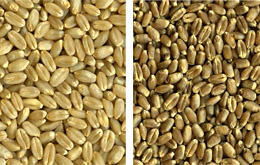This page has been archived and is being provided for reference purposes only. The page is no longer being updated, and therefore, links on the page may be invalid.
|
|
Sorting Technology for Red, White Wheat Kernels
By Sharon Durham
October 15, 2008
A small-scale imaging system that inspects and sorts wheat samples and other grains at moderate speeds with 95 to 99 percent accuracy has been developed by Agricultural Research Service (ARS) scientists and cooperators.
The use of imaging for high-speed sorting of agricultural products has been limited in part by the high cost of the equipment. The new system was developed by ARS engineer Tom Pearson and engineering technician Dan Brabec at the ARS Grain Marketing and Production Research Center (GMPRC) in Manhattan, Kan. The system was first tested by Scott Haley, a wheat breeder at Colorado State University, and has since been used by several other breeders across the country.
In the new system, suitable for small-scale operations, a single camera captures color images of three sides of each kernel, and a personal computer processes the images. The system sorts 30 kernels per second, which equates to slightly more than 7.5 pounds of wheat per hour.
After classification of kernel color, the computer sends a signal to activate an air valve to divert, or sort, the kernels into a secondary container. Hard red and hard white wheat kernels were used in this study. The rate of accuracy depends upon factors such as the degree of sample "weathering" from rain and the speed at which samples are fed through the system. This system is an economical and useful instrument for sorting wheat and other grains with high accuracy, according to Pearson.
Commercial color sorters can process up to 2,600 pounds of wheat per hour. However, lower throughput with associated lower machine costs and higher accuracy is better suited for small-scale operations, such as seed cleaning and selection for plant breeders, according to Pearson.
Color sorting would be useful to wheat breeders because they often sort seed by color, which is often linked to certain traits important to manufacturers of different products such as noodles. Wheat breeders typically have only small quantities of grain available for sorting, usually less than 10 pounds. For quantities of that size, the new system is more accurate and costs much less than larger-scale sorters.
Other applications for the sorter may include detecting scab-damaged wheat, fungal-infected corn, and estimating germ size of corn kernels.
ARS is a scientific research agency of the U.S. Department of Agriculture.


